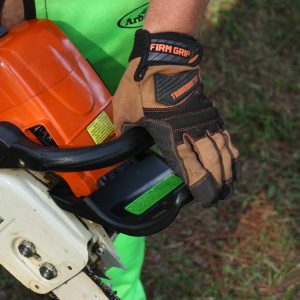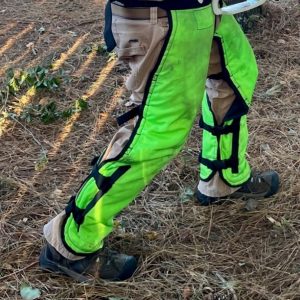Forestry

Many factors go into the safe and proper operation of a chainsaw. Learn appropriate handling techniques and body positioning.
More than 3 million chainsaws are sold in the United States each year to users with varying levels of skill and experience. This inherently dangerous piece of equipment combined with hazardous cutting situations and lack of personal protective equipment contributes to over 36,000 injuries each year.
Most chainsaw injuries are a result of operator error, such as holding, carrying, or starting the chainsaw improperly. Chainsaw injuries are not limited to cuts. Improper body posture and stance makes the operator more vulnerable to fatigue and lower back injuries. Proper ergonomics along with use of proper personal protective equipment will further reduce the likelihood of serious injury.
Danger of Rotational Kickback
The rotation of the chain around the bar creates strong reactive forces for the operator holding the chainsaw. Using the bottom of the bar causes the saw to pull away from the body, while using the top of the bar causes the saw to move toward the body (figure 1).

Figure 1. When cutting with the bottom of the bar, the saw pushes back toward the operator. Cutting with the top of the bar causes the chainsaw to pull away. Anticipate these forces by having a firm grip and boxer’s stance.

Figure 2. The depth gauge ensures that the cutter tooth removes only a thin sliver of wood. As the chain rotates down the end of the bar, however, the depth gauge opens and allows the tooth to cut too much wood, causing a rotational kickback.
Rotational kickback is the immediate upward force of the bar when the rotating chain attempts to remove a piece of wood that is too large or when the chain is moving too slowly to cut. Chains are designed with a depth gauge and cutting tooth, which ensure that saws remove only a thin sliver of wood. As the chain rotates around the end of the bar, however, the depth gauge opens, which allows the tooth to remove too much wood (figure 2). As the tooth bites into too much wood, it slows or stops, causing a violent opposite reaction in the form of a kickback.

Figure 3. The top quarter of the bar end is referred to as the no-go zone due to the danger for rotational kickbacks. Always be aware of the end of the saw and avoid contact in this zone.
Chances of rotational kickbacks can be reduced by avoiding the top corner, or no-go zone, when cutting (figure 3). Using a low kickback chain can further reduce chances of kickback.
While push-pull reactive forces often can be managed by proper saw handling, rotational kickback cannot. Situational awareness of the no-go zone when cutting along with maximizing control of the saw by maintaining proper hand, feet, and body posture reduces the risk of rotational kickbacks and other injuries.
Proper Hand Position
Proper hand position is the basis for safe chainsaw operation. Modern-day chainsaws are designed for right hand–dominant handling. This means that the right hand is on the rear handle and controls the throttle trigger. The left hand is on the front handle and guides the saw’s position. In proper handling, the left elbow is locked while cutting, and both hands are positioned with the thumbs wrapped completely around the handle (figure 4). This is particularly important on the front handle to control and limit rotational kickback (figure 5).
Always keep two hands on the saw when it is in operation. This position maximizes control of the saw and reduces chances of rotational kickback. Nearly half of all injuries occur on the left hand by operators holding a branch while cutting with the other hand. Fifty percent of injuries are preventable by always keeping two hands on the saw.
If you need to remove one hand, engage the chain brake. While keeping the left hand on the front handle, rotate your wrist and push the chain brake forward until it clicks, signaling it is engaged (figure 6). To disengage the chain brake, reach forward with four fingertips while keeping your thumb wrapped around the front handle, and pull the chain brake back until it clicks in place (figure 7).
- Figure 4. Keep two hands on the saw at all times. Wrap thumbs firmly around the front and rear handles. Always have the left hand on the front handle and right hand on the rear handle.
- Figure 5. Placing your thumb on the top of the front handle is a common mistake. This position does not provide a strong grip as when the thumbs are wrapped around the handle.
- Figure 6. To engage the chain brake, roll your wrist forward until the brake clicks in place.
- Figure 7. To release the chain brake, hook your thumb around the bar and extend four fingers forward to grab and pull back the break. It will click, signaling it is disengaged.
Proper Feet Position
Maintain a boxer’s stance when sawing to maximize stability. This stance allows you to remain balanced and more easily react to sudden movements from the saw. Firmly plant your feet on the ground shoulder width apart. Position your left foot forward and angle it at approximately 45 degrees to the right. Position your right foot slightly back from the left. Keep your knees slightly bent; never lock them (figure 8).
Chainsaws are often operated in areas where footing is unsure and debris poses tripping hazards. Be mindful of your footing as you cut and move with the saw. Usage guidelines recommend that the chain brake be engaged if you need to take more than one step while the chainsaw is running.
Never operate a chainsaw unless your feet are firmly planted on the ground. Never operate a chainsaw from an elevated position, such as a ladder, chair, stool, or front loader of a tractor. The risk of injury increases from falling as well as from debris striking you or your ladder. In these situations, use a pole pruner or power pole saw or hire a professional.
- Figure 8. Use a boxer’s stance (feet spread shoulder width with one foot slightly forward and one slightly back) to ensure that you don’t fall forward or backward when running the saw.
- Figure 9. Using your body to brace the saw can reduce push-pull reactive forces and increase overall control.
- Figure 10. Take a knee when cutting material located below mid-thigh. This places less strain on the lower back and allows greater control of the saw.
Proper Body Position
Proper body position while operating a chainsaw reduces fatigue and potential back injuries. While operating a saw, always keep your back straight and hold the saw close to your body. Using your body to brace the saw can help control the push-pull reactive forces from a rotating chain (figure 9).
The saw operational zone while standing is between the chest and thighs. Never attempt to cut anything that is above your shoulders. In this position, control of the saw is reduced, and risk of rotational kickback increases. For cutting situations below the thighs, take a knee (figure 10). Bending over causes back strain and could unbalance you should the saw or branch move.
Proper Head Position
Never take your eyes off the bar and saw kerf while operating a chainsaw. It is important to position the chainsaw on the right-hand side of your body, never centered, and to keep yourself to one side of the bar and saw kerf. This practice keeps your head and body out of the way in the event of a rotational kickback.
Be mindful of obstructions (knots and nails) in the wood you are cutting. Also be aware of what is directly past the chainsaw bar. Examples include other trees or debris that could cause rotational kickbacks or people who are helping with debris removal.
Carrying the Chainsaw

Figure 11. Always carry the saw with the chain brake engaged and the bar facing backwards. The engine housing should be between you and the bar.
Always keep the chain brake engaged when taking more than one step with the saw. When transporting the saw, keep it turned off with the chain brake engaged.
Carry the saw by the front handle in your left hand. The bar should be facing backwards (figure 11). This carrying technique places the bar and chain furthest from your body. With the bar facing backwards, you are less likely to encounter the bar and chain in the event of a fall.
Starting the Saw
Consult your operator’s manual for starting instructions for your specific chainsaw model. Never drop-start a chainsaw. A drop start involves holding the chainsaw by the rear handle while the other hand is used on the pull chord. This method is dangerous because the saw cannot be properly controlled. The risk of serious injury to yourself, someone around you, or the saw itself is more likely. There are two appropriate and safe methods to start a chainsaw:
Ground-Start Method
The ground-start method utilizes the stability of the ground and your body to secure the saw when starting. Place the chainsaw on a clean, flat surface as close to the work area as possible and engage the chain brake. Turn the saw to the on position and set the choke, if starting the saw cold.
While kneeling, place your left hand on the top of the handle and secure the saw with your foot in or on the hand guard (figure 12). Securing the saw with your knee on the rear of the saw, between the rear hand guard and front handle, is also an appropriate method (figure 13).
With your back straight, pull the cord in line with the cord assembly until the engine fires. At this point, disengage the choke and restart the saw.
- Figure 12. In a ground start, engage the chain brake, secure the rear handle with your right foot, and firmly hold the front handle with your left hand. Pull the start cord straight up with short powerful pulls.
- Figure 13. An alternative method for larger saws is to place your right knee on the chainsaw housing and follow the instructions for a ground start.
- Figure 14. The leg-lock starting technique is ideal for small- and medium-sized saws. It is quick, does not require bending over, and provides a way to securely hold the saw for starting.
Leg-Lock Method
The leg-lock method (figure 14) uses the stability of your legs and arms to secure the saw while starting. Follow the same initial steps as above, but instead of securing the saw on the ground, secure the rear handle of the saw between your thighs and rotate the saw to align the pull cord assembly with a vertical pulling motion. Use your left hand to secure the saw on the front handle. Pull the starting cord with the right hand.
Some chainsaws may be equipped with a decompression valve release. This button releases the saw’s engine compression and makes starting the saw easier. Use the decompression valve release prior to attempting to start the saw.
Injuries can occur to industry professionals or homeowners that rarely use a chainsaw, regardless of their experience level with a chainsaw. Following these proper guidelines can significantly reduce the risk of severe injury or even death.
 Bence Carter, Regional Extension Agent, and Beau Brodbeck, Extension Specialist, both with Forestry, Wildlife & Natural Resources, Auburn University
Bence Carter, Regional Extension Agent, and Beau Brodbeck, Extension Specialist, both with Forestry, Wildlife & Natural Resources, Auburn University
New January 2023, Chainsaw Safety: Ergonomics, FOR-2132











